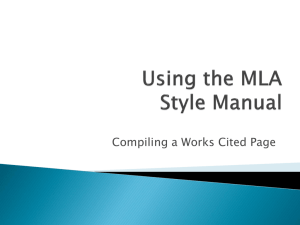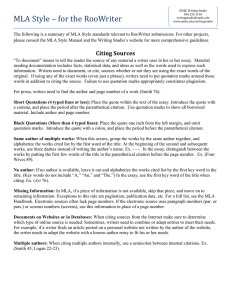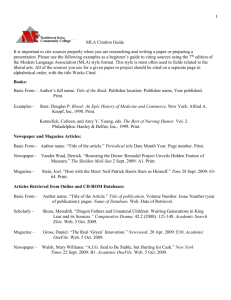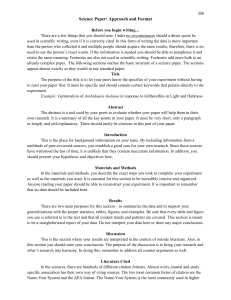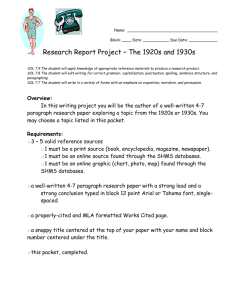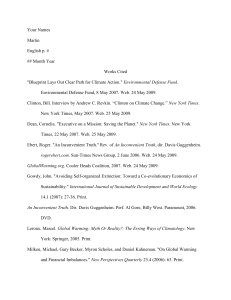How to Create a Works Cited" handout
advertisement
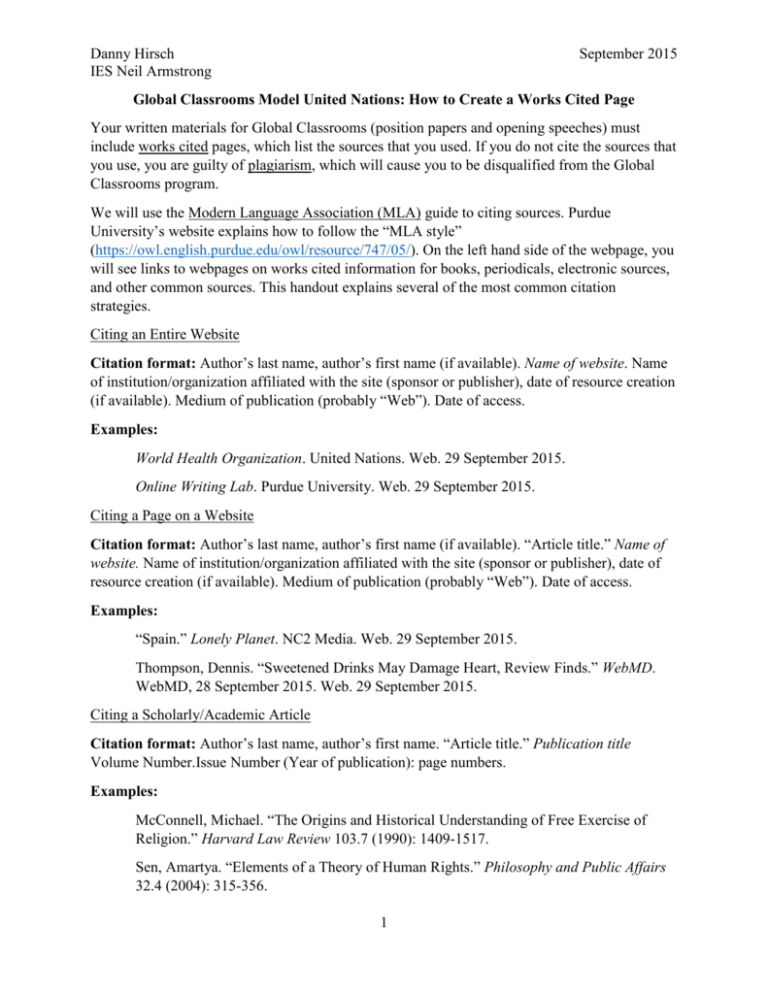
Danny Hirsch IES Neil Armstrong September 2015 Global Classrooms Model United Nations: How to Create a Works Cited Page Your written materials for Global Classrooms (position papers and opening speeches) must include works cited pages, which list the sources that you used. If you do not cite the sources that you use, you are guilty of plagiarism, which will cause you to be disqualified from the Global Classrooms program. We will use the Modern Language Association (MLA) guide to citing sources. Purdue University’s website explains how to follow the “MLA style” (https://owl.english.purdue.edu/owl/resource/747/05/). On the left hand side of the webpage, you will see links to webpages on works cited information for books, periodicals, electronic sources, and other common sources. This handout explains several of the most common citation strategies. Citing an Entire Website Citation format: Author’s last name, author’s first name (if available). Name of website. Name of institution/organization affiliated with the site (sponsor or publisher), date of resource creation (if available). Medium of publication (probably “Web”). Date of access. Examples: World Health Organization. United Nations. Web. 29 September 2015. Online Writing Lab. Purdue University. Web. 29 September 2015. Citing a Page on a Website Citation format: Author’s last name, author’s first name (if available). “Article title.” Name of website. Name of institution/organization affiliated with the site (sponsor or publisher), date of resource creation (if available). Medium of publication (probably “Web”). Date of access. Examples: “Spain.” Lonely Planet. NC2 Media. Web. 29 September 2015. Thompson, Dennis. “Sweetened Drinks May Damage Heart, Review Finds.” WebMD. WebMD, 28 September 2015. Web. 29 September 2015. Citing a Scholarly/Academic Article Citation format: Author’s last name, author’s first name. “Article title.” Publication title Volume Number.Issue Number (Year of publication): page numbers. Examples: McConnell, Michael. “The Origins and Historical Understanding of Free Exercise of Religion.” Harvard Law Review 103.7 (1990): 1409-1517. Sen, Amartya. “Elements of a Theory of Human Rights.” Philosophy and Public Affairs 32.4 (2004): 315-356. 1 Danny Hirsch IES Neil Armstrong September 2015 Citing an Article in a Newspaper Format: Author’s last name, author’s first name. “Title of Article.” Title of Periodical Day Month Year: pages (if available). Medium of publication (probably “Web” or “Print”). Examples: Gross, Jenny. “David Cameron Says Migrant Crisis Complicates British Debate on EU Membership.” Wall Street Journal 29 September 2015. Web. Mashal, Mujib. “Afghan Forces Seek to Regain Kunduz, Major Northern City, From Taliban.” New York Times 29 September 2015. Web. Citing an Article in a Magazine Format: Author’s last name, author’s first name. “Title of Article.” Title of Periodical Day Month Year: pages (if available). Medium of publication (probably “Web” or “Print”). Examples: Schjeldahl, Peter. “Going Downtown.” New Yorker 28 September 2015. Web. Shreeve, Jamie. “This Face Changes the Human Story. But How?” National Geographic 10 September 2015. Web. Citing a Book Format: Author’s last name, author’s first name. Title of Book. City of Publication (include state or country name if useful): Publisher, Year of Publication. Medium of Publication (usually “Print”). Note: For books with two or three authors, the author format should be: Lead author’s last name, lead author’s first name, second author’s first and last name, and third author’s first and last name. For books with more than three authors, the author format should be: Lead author’s last name, lead author’s first name, et al. Examples: Englebert, Pierre and Robert Dunn. Inside African Politics. Boulder, Colorado: Lynne Rienner Publishers, 2013. Print. Glendon, Mary Ann. A World Made New: Eleanor Roosevelt and the Universal Declaration of Human Rights. New York City: Random House, 2001. Print. Harris, David, et al. Law of the European Convention on Human Rights: Third Edition. Oxford, United Kingdom: Oxford University Press, 2014. Print. 2 Danny Hirsch IES Neil Armstrong September 2015 Sample Works Cited Page This is an example of a Works Cited page, taken from Purdue University’s Online Writing Lab’s “MLA Sample Works Cited Page” and following the 2009 MLA format. Works Cited "Blueprint Lays Out Clear Path for Climate Action." Environmental Defense Fund. Environmental Defense Fund, 8 May 2007. Web. 24 May 2009. Clinton, Bill. Interview by Andrew C. Revkin. “Clinton on Climate Change.” New York Times. New York Times, May 2007. Web. 25 May 2009. Dean, Cornelia. "Executive on a Mission: Saving the Planet." New York Times. New York Times, 22 May 2007. Web. 25 May 2009. Ebert, Roger. "An Inconvenient Truth." Rev. of An Inconvenient Truth, dir. Davis Guggenheim. rogerebert.com. Sun-Times News Group, 2 June 2006. Web. 24 May 2009. GlobalWarming.org. Cooler Heads Coalition, 2007. Web. 24 May 2009. Gowdy, John. "Avoiding Self-organized Extinction: Toward a Co-evolutionary Economics of Sustainability." International Journal of Sustainable Development and World Ecology 14.1 (2007): 27-36. Print. An Inconvenient Truth. Dir. Davis Guggenheim. Perf. Al Gore, Billy West. Paramount, 2006. DVD. Leroux, Marcel. Global Warming: Myth Or Reality?: The Erring Ways of Climatology. New York: Springer, 2005. Print. Milken, Michael, Gary Becker, Myron Scholes, and Daniel Kahneman. "On Global Warming and Financial Imbalances." New Perspectives Quarterly 23.4 (2006): 63. Print. Nordhaus, William D. "After Kyoto: Alternative Mechanisms to Control Global Warming." American Economic Review 96.2 (2006): 31-34. Print. ---. "Global Warming Economics." Science 9 Nov. 2001: 1283-84. Science Online. Web. 24 May 2009. Shulte, Bret. "Putting a Price on Pollution." Usnews.com. US News & World Rept., 6 May 2007. Web. 24 May 2009. Uzawa, Hirofumi. Economic Theory and Global Warming. Cambridge: Cambridge UP, 2003. Print. 3
